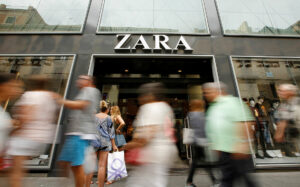LONDON – Investors want Zara owner Inditex to follow rivals H&M and Primark in making its full list of suppliers public so they can better assess any supply chain risks.
Inditex is an outlier among big clothing retailers in not publishing which factories it sources from. Regulators and investors want greater transparency and better disclosure from companies.
Clothing retailers, in particular, are under pressure to prove that there is no forced labor in their supply chains, and that garment workers are paid decent wages.
Chinese fashion group Shein has come under scrutiny from US lawmakers over supply chain risks ahead of plans for a US listing.
In the European Union, disagreements have stalled proposed rules that would require all big companies to disclose whether supply chains harm the environment or use child labor. Proposed sanctions for not complying could include fines of 5% of revenue.
Fashion brands and retailers, including Adidas, H&M, Hugo Boss, M&S, Nike, Primark, and Puma, already publish detailed supplier lists, including factory names and addresses.
Inditex publishes annually the number of suppliers it sources from in 12 core countries, but gives no information on individual factories.
Reuters asked Inditex shareholders what they wanted to see from the company in terms of improved disclosure.
In response, Dutch asset manager MN said: “In our engagement with Inditex one of the things we ask is if they could disclose a list of their suppliers and the geographical location.”
“Even though Inditex assures us that they have this data available, up until now Inditex is not willing to disclose this information unlike some industry peers who publish extensive supplier lists.”
MN, which manages Dutch pension fund assets, said it was important to have this insight to show whether Inditex has this information available, as well as for its own due diligence.
MN leads the Inditex dialogue for Platform Living Wage Financials (PLWF), a group of 20 institutional investors with combined assets under management of 6.58 trillion euros ($7.16 trillion). It works to promote higher income for garment and footwear industry workers.
Inditex, set to publish annual results on March 13, declined to comment on investors’ demands for it to publish its full supplier list.
“Inditex has a deep commitment to maintaining high standards in its supply chain, and believe that our industry-leading traceability system, which gives us maximum visibility of the supply chain, is key to this,” an Inditex spokesperson said.
Inditex founder Amancio Ortega holds a 59% stake in the company, with a 5% stake held by daughter Sandra Ortega. Together they are worth about $69 billion.
The five Inditex investors who responded to Reuters’ questions hold a combined stake of worth around $2 billion in the company, whose current valuation is about $140 billion.
None of the investors Reuters spoke to are considering divesting from Inditex.
MN said it advised its clients in December to divest from off-price retail chain TJX, which owns Homesense and TK Maxx, and they were divested as of January 1.
“Over the more than three years of engagement we have seen very little improvement on human rights due diligence in their global supply chain,” MN told Reuters.
TJX said it has strengthened its vendor code of conduct and expanded its factory auditing program in recent years.
MORE TRANSPARENCY
Inditex has an agreement with global trade union federation IndustriALL under which it provides it with its full list of suppliers. But IndustriALL wants wider disclosures from all companies, including Inditex, it said.
Know The Chain, a benchmarking initiative for companies and investors to address forced labor in supply chains, gave Inditex a lower overall score in its 2023 assessment than its 2021 assessment.
“The company is encouraged to strengthen its supply chain transparency by disclosing a full, rather than partial, list of its direct suppliers,” Know The Chain said.
Publishing its factories could bring more competition from Inditex rivals for the same suppliers, investors say.
Swetha Ramachandran, portfolio manager at Artemis Investment Management in London, wants to know what share of Inditex revenues is manufactured in each different supplier country. “It would help us determine their supply chain resilience,” she said.
Inditex’s published supply chain figures since 2019 show the company has cut suppliers in China and increased them in Bangladesh and Morocco. But it gives no details on the amount of products it buys from those suppliers.
Grace Su, portfolio manager at Clearbridge Investments, which holds Inditex shares, said she has asked for more clarity and supply chain disclosure.
“It’s very important because of all the scrutiny around ESG, and labor, and inputs. They claim to be a leader in this so it’s really important for them to actually have that level of disclosure.”
Inditex shareholder Schroders tracks companies’ awareness of manufacturing sites, and encourages apparel retailers, including Inditex, to be transparent, said Hannah Shoesmith, head of engagement at the firm.
Improved disclosure, among other environmental, sustainability and governance factors, could influence investment decisions, Marie Payne, responsible investment officer at Inditex shareholder Cardano, said.
Norway’s sovereign wealth fund, which has a $1.4 billion stake in Inditex, said it engages regularly with the company on supply chain risk management, human rights and transparency.
It declined to give details of those discussions. The fund said regarding companies’ supply chain practices in general that “there are continued challenges, including when it comes to traceability and reporting”. – Reuters

